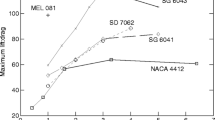Abstract
Small propeller-type wind turbines have a low Reynolds number, limiting the number of usable airfoil materials. Thus, their design method is not sufficiently established, and their performance is often low. The ultimate goal of this research is to establish high-performance design guidelines and design methods for small propeller-type wind turbines. To that end, we designed two rotors: Rotor A, based on the rotor optimum design method from the blade element momentum theory, and Rotor B, in which the chord length of the tip is extended and the chord length distribution is linearized. We examined performance characteristics and flow fields of the two rotors through wind tunnel experiments and numerical analysis. Our results revealed that the maximum output tip speed ratio of Rotor B shifted lower than that of Rotor A, but the maximum output coefficient increased by approximately 38.7%. Rotors A and B experienced a large-scale separation on the hub side, which extended to the mean in Rotor A. This difference in separation had an impact on the significant decrease in Rotor A’s output compared to the design value and the increase in Rotor B’s output compared to Rotor A.
Similar content being viewed by others
References
Glauert W. H., “Fans and Aerodynamics Theory IV”, Cambridge University Press, 1934, pp. 324–341.
Wilson R. E. and Lissaman P. B. S., “Applied Aerodynamics of Wind Power Machine”, NTIS PB 238594, Oregon State University, 1974.
Tokuyama H., Tanaka T. and Ushiyama I., “Experimentally Determining the Optimum Design Configuration for Micro Wind Turbine (The problems of present design)”, Journal of Wind Energy, Vol. 24, No. 1, 2000, pp. 65–70.
Tokuyama H. and Ushiyama I., “Experimentally Determining the Optimum Design Configuration for Micro Wind Turbine”, Journal of Wind Energy, Vol. 24, No. 4, 2000, pp. 62–65.
Jerson Rogério Pinheiro Vaz, João Tavares Pinho, André Luiz Amarante Mesquita, “An extension of BEM method applied to horizontal-axis wind turbine design”, Renewable Energy, Vol. 36, 2011, pp. 1734–1740.
Déborah Aline Tavares Dias do Rio Vaz, Jerson Rogério Pinheiro Vaz, André Luiz Amarante Mesquita, João Tavares Pinho and Antonio Cesar Pinho Brasil Junior, “Optimum aerodynamic design for wind turbine blade with a Rankine vortex wake”, Renewable Energy, Vol. 55, 2013, pp. 296–304.
Rajakumar S. and Ravindran D., “Iterative approach for optimising coefficient of power, coefficient of lift and drag of wind turbine rotor”, Renewable Energy, Vol. 38, 2012, pp. 83–93.
Hua Yang, Wenzhong Shen, Haoran Xu, Zedong Hong and Chao Liu, “Prediction of the wind turbine performance by using BEM with airfoil data extracted from CFD”, Renewable Energy, Vol. 70, 2014, pp. 107–115.
Nishizawa Y., Suzuki M., Taniguchi H., Ushiyama I., “An Experimental Study of the Shapes of Rotor for a Horizontal- Axis Small Wind Turbines”, Transactions of the Japan Society of Mechanical Engineers, Series B, Vol. 75, No. 751, 2009, pp. 547–549.
Nishizawa Y., Suzuki M., Taniguchi H., Ushiyama I., “An Experimental Study of the Shapes of Blade for a Horizontal- Axis Small Wind Turbines (Optimal Shape for Low Design Tip Speed of Rotor)”, Transactions of the Japan Society of Mechanical Engineers, Series B, Vol. 75, No. 753, 2009, pp. 1092–1100.
Koike M., “Fluid machinery engineering”, Corona Publishing, San Antonio, Texas, 2009, pp. 86–93.
Betz A., “Screw Propellers with Minimum Energy Loss”, Gottingen Reports, 1919, pp. 193–213.
Matsumiya H., Kogaki T., Iida M. and Kieda K., “Development of a high performance airfoil”, Turbomachinery, Vol. 29, No. 9, 2001, pp. 519–524.
ANSYS, Inc., “ANSYS CFX-Solver Theoretical guide”, 2010, pp. 22–23.
ANSYS, Inc., “ANSYS CFX-Solver Theoretical guide”, 2010, pp. 81–85.
ANSYS, Inc., “ANSYS CFX-Solver Modeling guide”, 2010, pp. 142–143.
Author information
Authors and Affiliations
Rights and permissions
About this article
Cite this article
Nishi, Y., Yamashita, Y. & Inagaki, T. Study on the rotor design method for a small propeller-type wind turbine. J. Therm. Sci. 25, 355–362 (2016). https://doi.org/10.1007/s11630-016-0871-x
Received:
Published:
Issue Date:
DOI: https://doi.org/10.1007/s11630-016-0871-x




